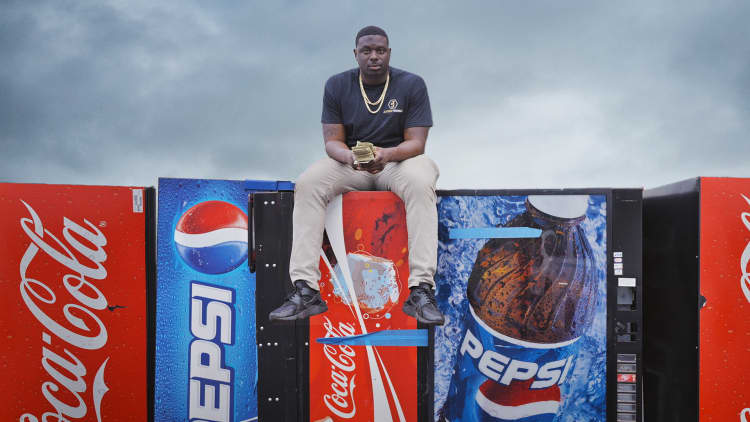Your favorite bartender is likely someone who can expertly mix your favorite drink while serving up a side of friendly banter. It's an experience that's difficult to top, but a group of scientists at an Italian university have tried to do just that, with a twist: Their ultimate bartender is a machine.
Researchers at Italy's University of Naples Federico II are developing a bartending robot, called BRILLO, that can not only whip up a cocktail but can also remember your favorite drink and have a conversation.
The university's team of computer scientists are using machine-learning algorithms to teach BRILLO, which is short for "Bartending Robot for Interactive Long-Lasting Operations," how to interact with human customers. The robot can gauge whether the tone of a conversation is serious or playful and even ask appropriate questions, or crack a joke, depending on the situation.
A team of researchers at the university's Projects of Intelligent Robotics and Advanced Cognitive Systems (PRISCA) lab started developing BRILLO in February 2020 through a partnership with Totaro Auotmazioni, an Italian manufacturer of food assembly line machines.
Earlier this year, the team shared a video of BRILLO on Twitter, showing off a robot with long, mechanical arms attached to a bow-tied torso and a human-like face.
Prof. Silvia Rossi, one of the project's lead researchers, tells CNBC Make It that the company asked her team to develop a machine capable of performing the functions of a bartender, particularly mixing drinks.
Rather than building what Rossi says could have simply been a cocktail "vending machine" — which already exists — the scientists decided to take the concept a step further to mimic the also important social aspects of a bartender's job.
The ability to interact with someone on a human-like level, is "the key [to] having a customer returning to the bartender," Rossi says.

Rossi's team was able to build off of existing research into AI algorithms that are already used to mimic human speech patterns. With some training, those would allow, for example, a robot bartender to recognize a customer, remember their favorite drink, and even ask them relevant questions based on details they'd previously shared.
The novel challenge that Rossi's team wanted to tackle was training an AI algorithm to study a customer's face and speech patterns in order to learn, in real time, what sort of interaction they might prefer to have. After all, it's important for your bartender to be aware of what type of mood you're in and whether you want to chat or be left alone to enjoy your drink.
"The novelty [is] using the machine learning algorithm to understand what I like to talk about," Rossi says.
Her team has also worked to teach BRILLO how to pick up on those all important social cues. It's an especially important ability for BRILLO to possess, Rossi says, because her team has discovered, through testing, that some people are understandably more hesitant to engage in conversation with a robot.
"You will discover that there are very different approaches when interacting with robots," she says. "So we decided, 'Why don't we use the same kind of algorithm, not only to learn the preferences and tastes of each person, but also his way of interacting and using this to make the robot able to learn and to adapt to each customer.'"
To teach BRILLO how to adapt to different situations and carry on a complex dialogue with customers, Rossi's team has spent the past two years training the algorithm with an endless stream of conversation topics. That's meant perfecting the robot's ability to start off conversations with a wide range of innocuous topics — pleasantries about the weather, for example — before determining from the customer's reactions whether it is appropriate to delve into more specific subjects, from politics to sports.
BRILLO is a pretty fast learner, Rossi says: "After three or four interactions, the robot is able to start fine-tuning the profile of the user in order to have a better, more focused conversation."
Beyond BRILLO: The future of AI and the service industry
More than simply recreating the experience of saddling up to your favorite bar but with a robot serving up drinks, the research behind a machine like BRILLO is an example of how computer scientists and other researchers around the world are working to push the boundaries of replicating human interaction with AI and machine-learning technology.
While experts believe that conversations between humans and self-aware AI programs are still likely decades away, Rossi and her team are far from the only scientists exploring how machine-learning tech can be applied to the service industry.
Rossi doesn't envision BRILLO, or any other robotic bartenders, replacing their human counterparts. Similarly, other researchers developing their own versions of robotic bartenders in recent years have suggested their best use could be to alleviate the workloads of human employees, especially in busy bars and restaurants, or even helping employers cope with labor shortages.
She sees broader potential applications for her team's research in the field of at-home health care, including robots using their improving communication skills to provide companionship and comfort to housebound patients in need of extra support from caregivers.
Privacy concerns will keep BRILLO out of a job—for now
BRILLO is not debuting in a bar near you anytime soon, Rossi says. Her team will be showcasing the robot and their research at some upcoming conferences in Italy later this year, she says, but they are also still ironing out wrinkles. For example: How to ensure the privacy of bar patrons discussing personal matters with an AI-enabled machine.
BRILLO the bartending robot currently exists "only for research purposes," according to Rossi, as the team works to ensure that a machine like BRILLO that uses facial recognition and other profiling technology will always be respectful of customers' privacy when handling potentially sensitive data.
"There are very challenging issues also from the privacy and ethical point of view, so we want to take care of [that]," she says.
Sign up now: Get smarter about your money and career with our weekly newsletter
Don't miss:
Forget electric toothbrushes: Tiny robots could one day brush and floss your teeth for you
Elon Musk says Tesla's humanoid Optimus robot 'will be worth more than the car business'


